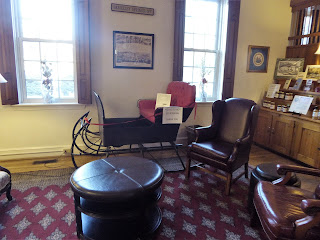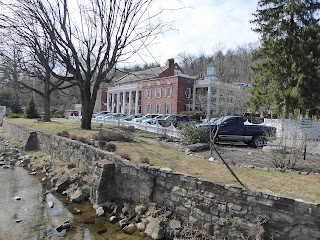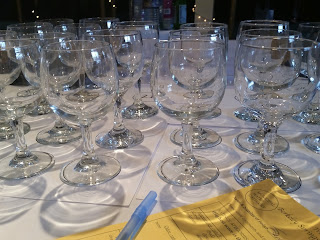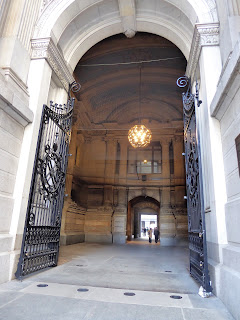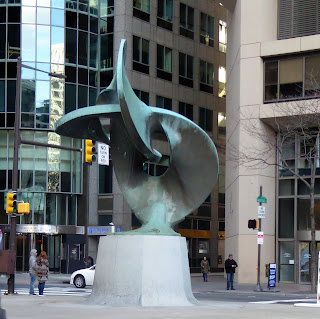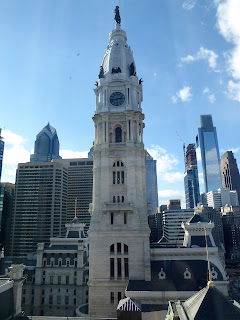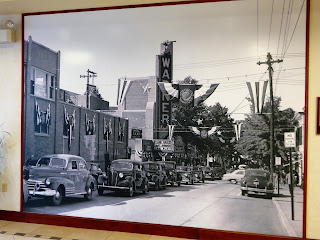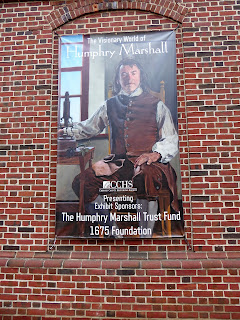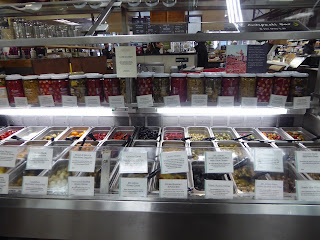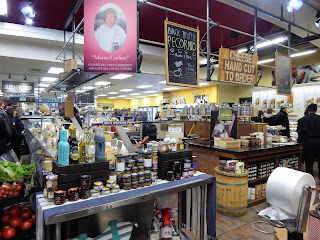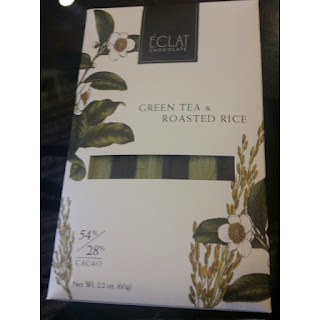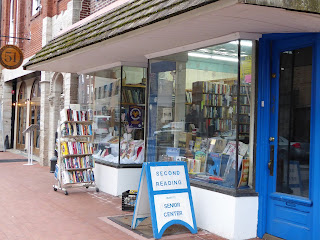 |
| The Gazebo in Berkeley Springs Park |
I needn't have fretted about frigid February weather. In an unexpected twist, temperatures climbed into the mid-70, and to think, just last year, the region was encased in ice just around that very same time.
Known for its Waters
Early bathers were known to have soaked in hollowed-out pools, with privacy provided by woven brush screens. Women and men would bathe on alternate days. I must admit I was just a little disappointed to learn that "George Washington's Bath Tub," which can be seen near the west side of Berkeley Springs State Park, is merely a representation of bathing conditions at the time.
During warmer weather, children and adults alike wade in the park's pools and channels. The Bathhouse is open all year round where visitors can, for a fee, luxuriate in jacuzzis, or in a walk-in "Roman Bath" filled with 750 gallons of mineral water, which is heated to a temperature of 102 degrees.
 |
| At Berkeley Springs park where guests can soak in heated mineral water. |
Staying in the Heart of the Action
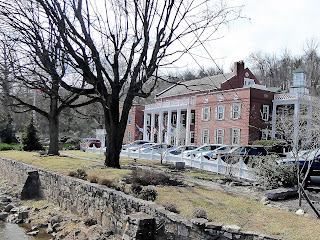 |
| The Country Inn dates back to 1932 and is located next to the Berkeley Springs State Park. |
 |
| Sitting rooms in the Country Inn. |
 |
| The Country Inn's onsight restaurant, The Morgan Tavern |
House upon the Hill, Moon is Lying Still
When entering the grounds of the Berkeley Springs State Park, your eye will be drawn upwards to a castle perched atop a steep cliff above the park. The odd structure seems a bit out of place and I couldn't help but be reminded of this old song sung by the inimitable Lizard King.
The medieval-looking castle, with it's carved cross located in the center of a turret, was nothing short of intriguing and I questioned our guide, Jeanne Mozier, about it. She provided me with a few details and only later did I discover that she wrote an entire book about the place, so I made it a point to purchase it at a local gift shop.
 |
| The Berkeley Castle |
Suit eventually ended up in Manhattan where he (once again) married the daughter of a business connection. This paved his way to a seat on the New York Stock Exchange.
The couple conceived two children, of which only one survived and marriage number two sadly ended in divorce.
By 1883, Suit was ready to marry again, perhaps feeling as if the third time would be a charm. The 51-year-old businessman likely raised a few eyebrows by marrying a woman who was 30 years his junior. Rosa, too, had "connections." Her father served one term in the U.S. Congress, worked at the U.S. Treasury and also practiced law.
By 1888 however, Suit's business connections were all for naught. He succumbed to illness, leaving the 27-year-old widow with, well, pretty much everything, on the caveat that she would never remarry.
According to Mozier, "After a brief period of mourning, Rosa launched what would be a decade of glittering parties" and although she never did remarry, rumor had it that she took on a lover. The noted horseman was also heir to "Ravenswood," another "cottage" estate nearby.
The local press reported breathlessly on the young widow's extravagant parties, from the decor of the mansion to the elite invitees, to the activities therein: "There was dancing to a coronet band and then a march to the supper room at 11:30 p.m. for a bountiful repast," reads one article.
The socialite seemed to revel in her role as "talk of the town." An interesting tidbit in the book mentions a smoking habit, which was considered a scandalous practice among women of the era. "The Hotel Dunn would order her gold-tipped Malachrino cigarettes, made especially for the ladies," reports Mozier.
Rosa's over-the-top lifestyle finally caught up with her and the creditors came a calling, prompting her to change her last name to Soult at one point. She was eventually booted from the castle, after a brief period of what appears, (from information provided in the book), to be squatting, although I doubt they used that term back in the day.
Over the years, aspiring entrepreneurs attempted to run the castle as a business venture. It was used as an artists' residence, a boys' camp and a tea room. Weddings were catered there as well.
Eventually, a man by the name of Walter Bird purchased the residence and gave it a little stability, conducting daily tours for a period of 50 years. The residence was later sold at auction and bought by investors in 2000. That relationship turned out to be short-lived and it was sold again in 2002 to an out-of-towner named Andrew Gosline who got caught up in the bidding on his birthday.
It has remained uninhabited since Gosline passed away in 2014 and has been closed to the public since.
Restaurants, Shops and More
Berkeley Springs is a compact little town, making it very walkable with a variety of shops and restaurants all within close proximity. A small museum situated at the far end of Berkeley Springs state park describes the area's history in a series of panels and is home to a 400-pound sandstone that was pulled from Warm Springs Ridge.
 |
| A 400-pound sandstone on display at the museum located on the grounds of Berkeley Springs State Park. |
Guests can even poke around the public library located downtown or take in a show at a historic old theater by the name of "The Star." Dining opportunities offer a little something for all tastes and budgets. During my visit, I enjoyed a stellar brunch prepared by Chef Devin Lucas at Tari's Cafe.
 |
| A spectacular brunch at Tari's Cafe on Washington Street |
 |
| The Star Theatre has been serving the area for 89 years now. |
 |
| The Naked Olive is one of the many shops that line the street. |
 |
| The Morgan County Public Library located in Berkeley Springs |






